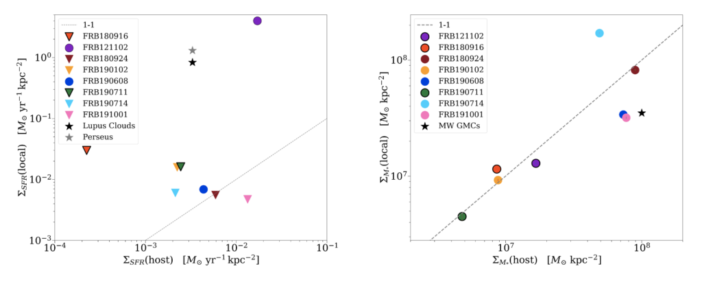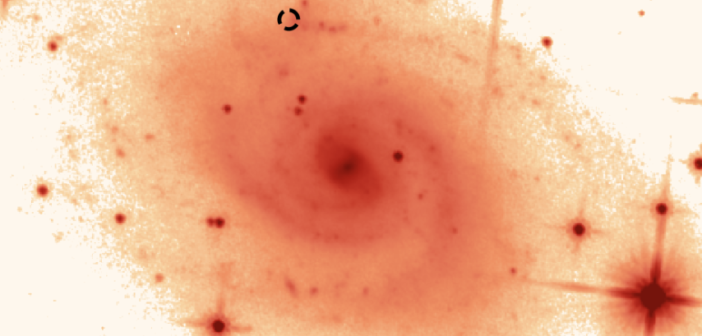Editor’s note: Astrobites is a graduate-student-run organization that digests astrophysical literature for undergraduate students. As part of the partnership between the AAS and astrobites, we occasionally repost astrobites content here at AAS Nova. We hope you enjoy this post from astrobites; the original can be viewed at astrobites.org.
Title: A High-Resolution View of Fast Radio Burst Host Environments
Authors: Alexandra G. Mannings et al.
First Author’s Institution: University of California, Santa Cruz
Status: Submitted to ApJ
First discovered in 2007, fast radio bursts (FRBs) have been the talk of the town for the last few years. As their name suggests, FRB sources emit very fast (millisecond-long) bursts of radiation at radio frequencies. Due to their very high dispersion measures (DMs), we know that FRBs are typically located in galaxies outside of the Milky Way, although the first galactic FRB was detected in March 2020. While the majority of FRBs are one-off events, some FRBs repeat, and two even repeat periodically! Even with the huge effort to study FRBs over the last few years, however, we still have much to learn about these objects.
In particular, while hundreds of FRBs have been discovered, we have only localized about a dozen FRBs to their respective host galaxies. Localizing FRBs is very important for auxiliary science, such as the missing baryon problem, and for determining what produces FRBs. By comparing FRB host environments with the hosts of other transients, we can hopefully determine whether FRBs might come from similar origins. This is what today’s authors explore!
Hubble for the Win!
The authors use infrared (IR) and ultraviolet (UV) observations from the Hubble Space Telescope to study the host galaxies of eight different FRBs. Six of these observations are newly presented, while the host galaxy of the infamous FRB 121102 (the first repeating FRB) and FRB 180916 (the first periodic FRB) were reported in previous studies.
So What Is Cooking for These Eight FRBs?
First, the authors locate the FRBs within their host galaxies. Of the eight FRBs, five are located within spiral galaxies as shown below in Figure 1. This is not unexpected, as ~60% of the observed galaxies in our universe are spiral galaxies. While they are located within the spiral arms of their hosts, the five FRBs are not actually located at the brightest points of the spiral arms (but note that they have huge error regions!).
The authors are also able to convert the UV light at the position of the FRB to the star formation rate density at this position, and the IR light at the position of the FRB to the stellar mass surface density at this location. As shown below in Figure 2, only FRB 121102 and FRB 180916 lie in areas with a lot of star formation (and the star formation rate for FRB 180916 is an upper limit). The other FRBs tend to lie in more moderate, although slightly higher than average, regions. This is a bit surprising as young magnetars, a very popular origin for FRBs, are typically located very close to points of high star formation.
There is almost a perfect 1:1 correlation between the stellar mass surface density at the location of the FRB and the average for the FRB’s galaxy, suggesting that FRBs lie in typical surface mass density regions within their host galaxies.

Figure 2: Left: Comparison between the star formation rate density for different FRBs as compared with the average for the host. There is no clear relation between the two, but we note that many of the observations are upper limits (indicated with triangles). Right: Comparison between the stellar mass surface density for different FRBs as compared with the average for the host. There is almost a perfect 1:1 relation between the two. [Mannings et al. 2021]
- The distance between the FRB and the center of the host galaxy, i.e., the radial offset.
- The distance between the FRB and the center of the host galaxy after normalizing by the size of the galaxy, i.e., the normalized radial offset.
- The brightness of the galaxy at the location of the FRB as compared to the brightness throughout the galaxy in the UV band. The UV light can be used as a proxy for star formation within a galaxy.
- The brightness of the galaxy at the location of the FRB as compared to the brightness throughout the galaxy in the IR band. The IR light can be used as a proxy for stellar mass within the host.
- The amount of light within the galaxy that is interior to the FRB’s location, known as the enclosed flux.
The authors compare these properties of FRBs within their hosts to that of six different transient phenomena: long duration gamma-ray bursts (LGRBs) short-duration gamma-ray bursts (SGRBs), Ca-rich transients, Type Ia supernovae (Type Ia SNe), core-collapse SNe (CCSNe), and super-luminous SNe (SLSNe). While it can be a bit difficult to remember all of these different transients, they can generally be lumped into three different categories: 1. Massive star explosions (LGRBs, CCSNe, SLSNE) 2. Explosions involving older stellars objects such as neutron star mergers (SGRBs) or white dwarfs (Type Ia SNe), and 3. Objects with unknown origins (Ca-rich transients).
From their comparisons, the authors find that the properties of LGRBs, SGRBs, SLSNe and Ca-rich transients are inconsistent with those of FRBs. The table below indicates which properties are inconsistent for each of these transients (marked with X). The authors cannot rule out CCSNe and Type Ia SNE as being associated with FRBs. This is similar to another recent result that finds FRBs are consistent with CCSNe (and hence magnetars born from CCSNe) but different from this result that finds it unlikely that Type Ia SNe are associated with every FRB.
| LGRBs | SGRBs | Type Ia SNe | CCSNe | SLSNe | Ca-rich transients | |
| Radial Offset | X | X | ||||
| Normalized Radial Offset | X | X | ||||
| Brightness in UV | X | X | ||||
| Brightness in IR | X | X |
For the fifth property, the enclosed flux, the authors don’t compare the distribution from the FRBs to that of the other transients. Instead, they only conclude that the FRBs appear to trace the distribution of light within their host galaxies.
So Where Does This Leave Us?
If there is one key transient associated with FRBs, then this work suggests that it is not LGRBs, SGRBs, SLSNe, or Ca-rich transients. However, there is one very important caveat to the authors’ work, which is that they group repeating and non-repeating FRBs together in their sample. So it is possible that there is not just one but multiple mechanisms responsible for the FRBs within their sample. Thus, the mystery of what produces FRBs continues…
Original astrobite edited by Viraj Karambelkar.
About the author, Alice Curtin:
I’m a second year MsC student at McGill University studying Fast Radio Burts and pulsars using the Canadian Hydrogen Mapping Experiment (CHIME). My work mainly focuses on characterizing radio frequency interference, investigating multi-wavelength counterparts to FRBs, and using pulsars as calibrators of future instruments. When not doing research, I typically find myself teaching physics to elementary school students, spending time with friends, or doing something active outside.

